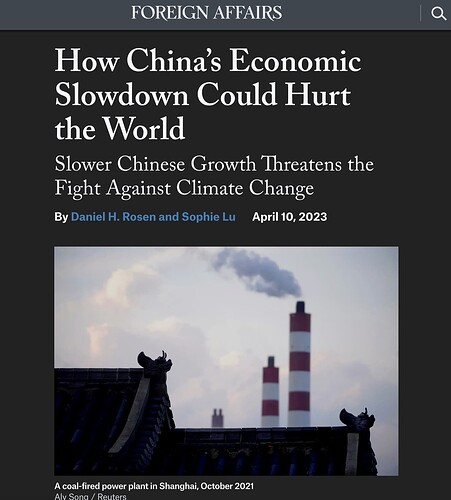-
自1978年以来,由于市场导向政策,中国的人均收入经历了快速增长
-
然而,政府对改革的痛苦影响的容忍度越来越低,导致增长放缓。
-
这种转变对经济以及北京的经济去碳化努力产生了深远的影响。
-
北京需要接受经济改革,以维持增长并加快实现气候目标。
-
中国经济的困境将影响其他国家的经济
-
北京必须改变方向,进行改革,以确保经济放缓不会危及繁荣或地球。
-
中国报告的年增长率只有3%,远远低于其5.5%的目标。
-
实际情况可能更糟,去年的经济有可能出现萎缩。
-
北京的领导人将这一结果归因于大流行的因素,今年的目标是GDP增长 “5%左右”。
-
乐观人士断言,经济将恢复到之前的快速发展,但十年来,经济增长的极限已经很明显。
-
对潜在经济增长的长期预测取决于三个因素:人口统计学、资本投资和生产力。
-
人口限制是不可避免的,到2040年,中国65岁以上的人口数量将翻倍。
-
由于企业和银行违约、财政短缺和投资回报率下降,投资带动的增长在未来不能发挥那么大的作用。
-
生产力增长已经下降到低水平,需要将经济表现置于政治优先事项之上。
-
大流行时期的做法与刺激改革相反,它认可了更多的国家控制和行政干预。
-
我们提出了两条前进的道路:国家主义和改革。
-
国家主义将维持房地产泡沫,并将资本锁定在低回报行业,而改革将带来中期的低增长,但到2030年可能会有4%的增长。
-
超高增长的日子已经过去,但这是衡量中国成功的一个标准。
-
中国国内生产总值的能源和碳强度下降速度较慢,自2020年以来,能源强度的减少停滞不前。中国也不再为这些减少设定年度目标,他们的二氧化碳排放很可能在2030年前达到峰值。
-
中国正在更多地依赖非化石燃料能源,他们的二氧化碳排放量似乎保持平稳或略有下降。然而,依靠旧的模式和将改革再推迟五年,将使中国很难在2030年之前达到他们的排放强度目标。
-
中国需要鼓励更有经济效益、更低排放的增长,并停止建设依赖煤炭的工业能力,以确保到2060年有序地、低成本地过渡到净零排放。今天为帮助实现增长而花在碳密集型资产上的钱,明天会造成浪费的金融负债,使绿色转型的成本更难管理。
-
美中气候行动在特朗普总统的领导下已经瓦解
-
需要有护栏来保持全球气候雄心的正常运行
-
中国可以加入美国主导的甲烷减排行动计划
-
两国都应投资于绿色技术
-
由于增长放缓,中国的决策者可能会牺牲在绿色倡议上的支出
-
需要昂贵的基础设施投资来适应气候变化
-
北京需要认识到经济放缓是一个长期趋势
-
增长放缓可能影响全球南方
-
气候技术供应链的成本降低
-
华盛顿与中国经济部分脱钩可能损害自身利益
-
中国的增长不足可能会伤害到世界其他地区
-
China has experienced rapid growth in per capita income since 1978, due to market-oriented policies
-
However, the government has become less tolerant of the painful effects of reform, leading to a slow-down in growth
-
This shift has had profound effects on the economy, and on Beijing’s efforts to decarbonize the economy
-
Beijing needs to embrace economic reforms in order to sustain growth and ramp up climate goals
-
The travails of the Chinese economy will affect the economies of other countries
-
Beijing must change course and institute reforms to ensure that the slowdown does not endanger prosperity, or the planet
-
China reported only three percent annual growth, far less than its 5.5 percent goal.
-
The real rate may have been worse, with the economy potentially contracting last year.
-
Leaders in Beijing attribute this result to pandemic factors, with a target of “around five percent” GDP growth for this year.
-
Optimists assert the economy will revert to its prior fast pace, but the limits to its growth have been apparent for a decade.
-
Long-term projections of potential economic growth rest on three factors: demographics, capital investment, and productivity.
-
Demographic limits are inescapable, with the number of Chinese people over 65 doubling by 2040.
-
Investment-led growth cannot play as big a role in the future due to business and bank defaults, fiscal shortfalls, and falling returns on investment.
-
Productivity growth has already fallen to low levels, requiring economic performance to be placed above political priorities.
-
The pandemic period did the opposite of spur reforms, sanctioning more state control and administrative intervention.
-
Two paths forward are presented: statism and reform.
-
Statism would sustain the property bubble and lock up capital in low-return sectors, while reform would bring lower growth in the medium-term but potentially four percent growth by 2030.
-
The days of super-high growth are over, but this is a measure of China’s success.
-
China’s energy and carbon intensity of GDP have been decreasing at a slower rate, with energy intensity reductions stagnating since 2020. China has also stopped setting annual targets for these reductions, and it is likely that their carbon dioxide emissions will peak before 2030.
-
China is relying more on nonfossil fuel sources of energy, and their carbon dioxide emissions appear to have either stayed flat or decreased slightly. However, relying on old models and delaying reforms for another half decade will make it hard for China to reach their emissions intensity targets by 2030.
-
China needs to encourage more economically efficient, lower-emissions growth, and stop building industrial capacity reliant on coal to ensure an orderly, low-cost transition to net-zero emissions by 2060. Money spent on carbon-intensive assets today to help deliver growth will create wasteful financial liabilities tomorrow that will make the cost of a green transition harder to manage.
-
U.S.-Chinese climate action has broken down under President Trump
-
Need for guardrails to keep global climate ambitions on track
-
China can join U.S.-led Methane Emissions Reduction Action Plan
-
Both countries should invest in green technology
-
Chinese policymakers may sacrifice spending on green initiatives due to slower growth
-
Need for costly infrastructure investments to adapt to climate change
-
Beijing needs to recognize slowdown as a longer trend
-
Slower growth may affect global South
-
Lower costs of climate tech supply chain
-
Washington’s partial decoupling from Chinese economy may undermine own interests
-
China’s growth shortfall could hurt rest of the world
